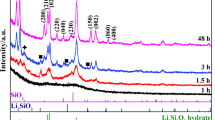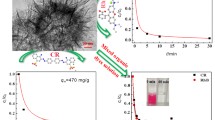Abstract
Li2SiO3 is a potential new material for mitigating environmental issues such as greenhouse effect and wastewater treatment, but the high-quality failure and evolvable morphology limit have restricted its large-scale application. Herein, a high-quality hierarchically hollow-structured Li2SiO3 assembled by tunable secondary structures was precisely fabricated by an efficient green and facile hydrothermal method. The secondary structures, from nanosheets to belts, thorns, spinule and eventually to nanoparticles, accompanying the corresponding morphologies evolving from peony-like to chrysanthemum-like, urchin-like, waxberry-like and eventually to spherical structures, could be tuned by adjusting precursors’ Li/Si molar ratios. All of the obtained hollow Li2SiO3 structures were attributed to a common growth mechanism called inside-out Ostwald ripening. The as-prepared hollow Li2SiO3 structures were experimented as heavy metal adsorbents for the first time and exhibited excellent adsorption performance for all employed heavy metal ions (Cu2+, Mn2+ and Ni2+). Furthermore, as a case study, the obtained heavy metal-bearing Li2SiO3 architectures (Cu(OH)2@Li2SiO3, MnO(OH)2@Li2SiO3 and Ni(OH)2@Li2SiO3) inherited the primary hollow morphology, which endowed them with reusability as high-efficient adsorbents for methylene blue by color removal efficiency higher than 98%. This work lays the foundation for the development of an environmentally friendly “two birds with one stone” route of “remover of heavy metal ions to dye adsorbent,” which will be of great significance for the wastewater treatment.
Graphic Abstract












Similar content being viewed by others
References
Wu G, Kang HB, Zhang XY, Shao HB, Chu LY, Ruan CJ (2010) A critical review on the bio-removal of hazardous heavy metals from contaminated soils: issues, progress, eco-environmental concerns and opportunities. J Hazard Mater 174(1–3):1–8
Srivastava NK, Majumder CB (2008) Novel biofiltration methods for the treatment of heavy metals from industrial wastewater. J Hazard Mater 151(1):1–8
Borba CE, Guirardello R, Silva EA, Veit MT, Tavares CRG (2006) Removal of nickel(II) ions from aqueous solution by biosorption in a fixed bed column: experimental and theoretical breakthrough curves. Biochem Eng J 30(2):184–191
Paulino AT, Minasse FAS, Guilherme MR, Reis AV, Muniz EC, Nozaki J (2006) Novel adsorbent based on silkworm chrysalides for removal of heavy metals from wastewaters. J Colloid Interface Sci 301(2):479–487
Naseem R, Tahir SS (2001) Removal of Pb(II) from aqueous/acidic solutions by using bentonite as an adsorbent. Water Res 35(16):3982–3986
Khezami L, Capart R (2005) Removal of chromium(VI) from aqueous solution by activated carbons: kinetic and equilibrium studies. J Hazard Mater 123(1–3):223–231
Wang Q, Luo JZ, Zhong ZY, Borgna A (2011) CO2 capture by solid adsorbents and their applications: current status and new trends. Energy Environ Sci 4(1):42–55
Pires JCM, Martins FG, Alvim-Ferraz MCM, Simoes M (2011) Recent developments on carbon capture and storage: an overview. Chem Eng Res Des 89(9):1446–1460
Olivares-Marín M, Maroto-Valer MM (2012) Development of adsorbents for CO2 capture from waste materials: a review. Greenh Gases Sci Technol 2(1):20–35
MacDowell N, Florin N, Buchard A, Hallett J, Galindo A, Jackson G, Adjiman CS, William CK, Shah N, Fennell P (2010) An overview of CO2 capture technologies. Energy Environ Sci 3(11):1645–1669
Ku Y, Jung IL (2001) Photocatalytic reduction of Cr(VI) in aqueous solutions by UV irradiation with the presence of titanium dioxide. Water Res 35(1):135–142
Mirbagheri SA, Hosseini SN (2005) Pilot plant investigation on petrochemical wastewater treatment for the removal of copper and chromium with the objective of reuse. Desalination 171(1):85–93
Alvarez MT, Crespo C, Mattiasson B (2007) Precipitation of Zn(II), Cu(II) and Pb(II) at bench-scale using biogenic hydrogen sulfide from the utilization of volatile fatty acids. Chemosphere 66(9):1677–1683
El Hadri N, Quang DV, Goetheer ELV, Abu Zahra MRM (2017) Aqueous amine solution characterization for post-combustion CO2 capture process. Appl Energy 185(Part 2):1433–1449
Bello A, Idem RO (2006) Comprehensive study of the kinetics of the oxidative degradation of CO2 loaded and concentrated aqueous monoethanolamine (MEA) with and without sodium metavanadate during CO2 absorption from flue gases. Ind Eng Chem Res 45(8):2569–2579
Ma X, Wang X, Song C (2009) “Molecular basket” sorbents for separation of CO2 and H2S from various gas streams. J Am Chem Soc 131(6):5777–5783
Alcántar-Vázquez B, Díaz Herrera PR, González AB, Duan YH, Pfeiffer H (2015) Analysis of the CO2–H2O chemisorption in lithium silicates at low temperatures (30–80 °C). Ind Eng Chem Res 54(27):6884–6892
Ortiz-Landeros J, Gómez-Yáñez C, Pfeiffer H (2011) Surfactant-assisted hydrothermal crystallization of nanostructured lithium metasilicate (Li2SiO3) hollow spheres: II—textural analysis and CO2–H2O sorption evaluation. J Solid State Chem 184(8):2257–2262
Duan YH, Pfeiffer H, Li BY, Romero-Ibarra IC, Sorescu DC, Luebke DR, Halley JW (2013) CO2 capture properties of lithium silicates with different ratios of Li2O/SiO2: an ab initio thermodynamic and experimental approach. Phys Chem Chem Phys 15(32):13538–13558
Wang K, Wang XY, Zhao PF, Guo X (2014) High-temperature capture of CO2 on lithium-based sorbents prepared by a water based sol–gel technique. Chem Eng Technol 37(9):1552–1558
Subha PV, Nair BN, Hareesh P, Mohamed AP, Yamaguchi T, Warrier KGK, Hareesh US (2014) Enhanced CO2 absorption kinetic in lithium silicate platelets synthesized by a sol–gel approach. J. Mater. Chem A 2(32):12792–12798
Olivares-Marín M, Drage TC, Maroto-Valer MM (2010) Novel lithium-based sorbents from fly ashes for CO2 capture at high temperatures. Int J Greenh Gas Control 4(4):623–629
Pfeiffer H, Bosch P, Bulbulian S (1998) Synthesis of lithium silicates. J Nucl Mater 257(3):309–317
Cruz D, Bulbulian S (2003) Synthesis of lithium silicate tritium breeder powders by a modified combustion method. J Nucl Mater 312(2–3):262–265
Zhang B, Easteal AJ (2008) Effect of HNO3 on crystalline phase evolution in lithium silicate powders prepared by sol–gel processes. J Mater Sci 43(15):5139–5142
Alemi A, Khademinia S, Joo SW et al (2013) Lithium metasilicate and lithium disilicate nanomaterials: optical properties and density functional theory calculations. Int Nano Lett 3(1):1–11
Ortiz-Landeros J, Contreras-García ME, Gomez-Yáñez C, Pfeiffer H (2011) Surfactant-assisted hydrothermal crystallization of nanostructured lithium metasilicate (Li2SiO3) hollow spheres: (I) synthesis, structural and microstructural characterization. J Solid State Chem 184(5):1304–1311
Li XY, Yang HM (2014) Morphology-controllable Li2SiO3 nanostructures. CrystEngComm 16(21):4501–4507
Pfeiffer H (2010) Advances in CO2 conversion and utilization in advances on alkaline ceramics as possible CO2 captors, chapter 15. In: ACS symposium series. 1056: 233–253
Kim T, Olek J (2016) The effects of lithium ions on chemical sequence of alkali–silica reaction. Cem Concr Res 79:159–168
Mitchell LD, Beaudoin JJ, Grattan-Bellew P (2004) The effects of lithium hydroxide solution on alkali silica reaction gels created with opal. Cem Concr Res 34(4):641–649
Feng X, Thomas MDA, Bremner TW, Folliard KJ, Fournier B (2010) New observations on the mechanism of lithium nitrate against alkali silica reaction (ASR). Cem Concr Res 40(1):94–101
Leemann A, Lörtscher L, Bernard L, Saout GL, Lothenbach B, Espinosa-Marzal RM (2014) Mitigation of ASR by the use of LiNO3—characterization of the reaction products. Cem Concr Res 59:73–86
Yang AX, Wang HJ, Li W, Shi JL (2012) Synthesis of lithium metasilicate powders at low temperature via mechanical milling. J Am Ceram Soc 95(6):1818–1821
Molla AR, Chakradhar RPS, Kesavulu CR, Rao JL, Biswas SK (2012) Microstructure, mechanical, epr and optical properties of lithium disilicate glasses and glass-ceramics doped with Mn2+ ions. J Alloys Compd 512(1):105–114
Zhang B, Nieuwoudt M, Easteal AJ (2008) Sol–gel route to nanocrystalline lithium metasilicate particles. J Am Ceram Soc 91(6):1927–1932
Yin ZG, Wang K, Zhao PF, Tang XL (2016) Enhanced CO2 chemisorption properties of Li4SO4, using a water hydration–calcination technique. Ind Eng Chem Res 55(4):1142–1146
Kruk M, Jaroniec M (2001) Gas adsorption characterization of ordered organic–inorganic nanocomposite materials. Chem Mater 13(10):3169–3183
Chen X, Qiao M, Xie S, Fan K, Zhou W, He HJ (2007) Self-construction of core−shell and hollow zeolite analcime icositetrahedra: a reversed crystal growth process via oriented aggregation of nanocrystallites and recrystallization from surface to core. Am Chem Soc 129(43):13305–13312
Yu XX, Yu JG, Cheng B, Huang BB (2009) One-pot template-free synthesis of monodisperse zinc sulfide hollow spheres and their photocatalytic properties. Chem Eur J 15(27):6731–6739
Ostwald W (1897) Studien über die Bildung und Umwandlung fester Körper. Z Phys Chem 22(1):289–330
Deroubaix G, Marcus P (1992) X-ray photoelectron spectroscopy analysis of copper and zinc oxides and sulphides. Surf Interface Anal 18(1):39–46
Akhavan O, Azimirad R, Safa S, Hasani E (2011) CuO/Cu(OH)2 hierarchical nanostructures as bactericidal photocatalysts. J Mater Chem 21(26):9634–9640
Boileau A, Capon F, Coustel R, Laffez P, Barrat S, Pierson JF (2017) Inductive effect of Nd for Ni3+ stabilization in NdNiO3 synthesized by reactive DC cosputtering. J Phys Chem C 121(39):21579–21590
Greiner MT, Helander MG, Wang ZB, Tang WM, Lu ZH (2010) Effects of processing conditions on the work function and energy-level alignment of NiO thin films. J Phys Chem C 114(46):19777–19781
Garcia T, Sellick D, Varela F, Vázquez I, Dejoz A, Agouram S, Taylor SH, Solsona B (2013) Total oxidation of naphthalene using bulk manganese oxide catalysts. Appl Catal A 450(15):169–177
Lee G, Song K, Bae G (2011) Permanganate oxidation of arsenic(III): reaction stoichiometry and the characterization of solid product. Geochim Cosmochim Acta 75(17):4713–4727
Lv G, Bin F, Song CL, Wang KP, Song JO (2013) Promoting effect of zirconium doping on Mn/ZSM-5 for the selective catalytic reduction of NO with NH3. Fuel 107:217–224
Hao SM, Zhu ZS, Zhang XY, Wang QQ, Yu ZZ (2016) Hollow manganese silicate nanotubes with tunable secondary nanostructures as excellent fenton-type catalysts for dye decomposition at ambient temperature. Adv Funct Mater 26(40):7334–7342
Gao J, Sun SP, Zhu WP, Chung TS (2014) Chelating polymer modified P84 nanofiltration (NF) hollow fiber membranes for high efficient heavy metal removal. Water Res 63:252–261
Kuwahara Y, Tamagawa S, Fujitani T, Yamashita H (2013) A novel conversion process for waste slag: synthesis of calcium silicate hydrate from blast furnace slag and its application as a versatile adsorbent for water purification. J Mater Chem A 1(24):7199–7210
You W, Hong M, Zhang H, Wu Q, Zhuang Z, Yu Y (2016) Functionalized calcium silicate nanofibers with hierarchical structure derived from oyster shells and their application in heavy metal ions removal. Phys Chem Chem Phys 18(23):15564–15573
Huang RY, Wu MJ, Zhang T, Li DQ, Tang PG, Feng YJ (2017) Template-free synthesis of large-pore-size porous magnesium silicate hierarchical nanostructures for high-efficiency removal of heavy metal ions. ACS Sustain Chem Eng 5(3):2774–2780
Shi HC, Li WS, Zhong L, Xu CJ (2014) Methylene blue adsorption from aqueous solution by magnetic cellulose/graphene oxide composite: equilibrium, kinetics, and thermodynamics. Ind Eng Chem Res 53(3):1108–1118
Feng M, You W, Wu ZS, Chen QD, Zhan HB (2013) Mildly alkaline preparation and methylene blue adsorption capacity of hierarchical flower-like sodium titanate. ACS Appl Mater Interfaces 5(23):12654–12662
Acknowledgements
We thank the National Key R&D Program of China (Grant No. 2017YFB0310300) and the National Natural Science Foundation of China (Grant No. 51672209) for the support of this work. We also thank Pro. Wei Wang and Pro. Shengwu Guo for operating the instruments of FE-SEM and HRTEM.
Author information
Authors and Affiliations
Corresponding author
Additional information
Publisher's Note
Springer Nature remains neutral with regard to jurisdictional claims in published maps and institutional affiliations.
Rights and permissions
About this article
Cite this article
Zhang, H., Yang, J. Hollow Li2SiO3 architectures with tunable secondary nanostructures and their potential application for the removal of heavy metal ions. J Mater Sci 55, 3845–3859 (2020). https://doi.org/10.1007/s10853-019-04219-8
Received:
Accepted:
Published:
Issue Date:
DOI: https://doi.org/10.1007/s10853-019-04219-8




